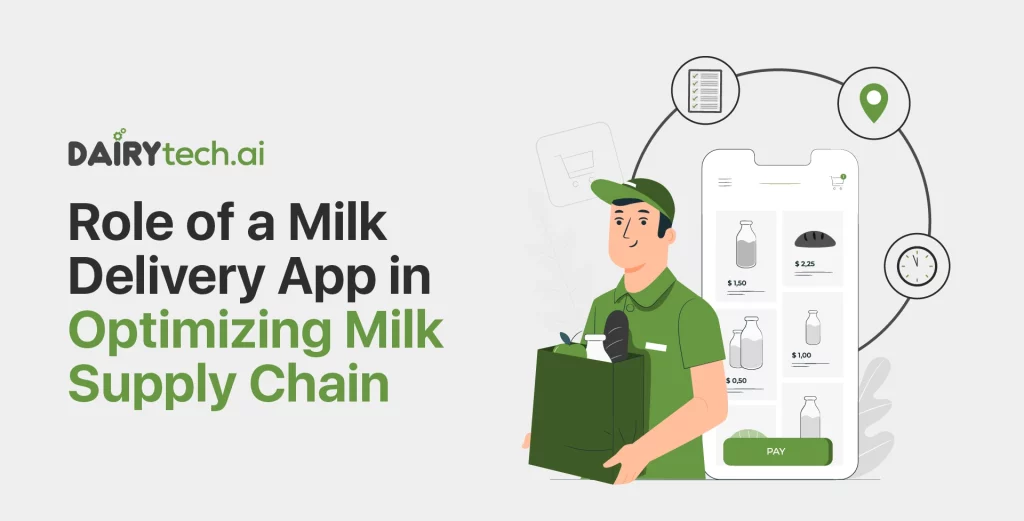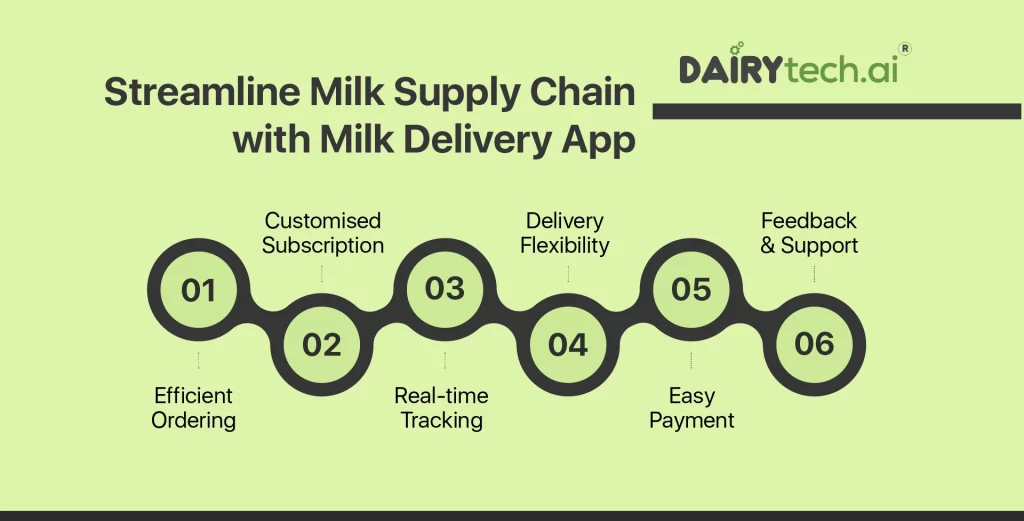Role of a Milk Delivery App in Optimizing Milk Supply Chain

It is no surprise that, in an age when technology seamlessly integrates into our daily lives, the dairy industry has embraced digital solutions to optimize its supply chain. The milk delivery app has transformed the way milk is managed and delivered for both consumers and suppliers.
The effectiveness and prosperity of many industries are largely dependent on supply chain optimisation. Technology has brought about a significant change in the dairy and milk delivery industries, with milk delivery apps becoming essential resources for optimising the whole milk supply chain.
The functions of a milk delivery app go beyond traditional milk distribution techniques, completely changing the sourcing, administration, and customer delivery of dairy products. These apps have helped improve the milk supply chain’s accuracy, efficiency, and convenience by utilising technology, which is advantageous for both dairy farmers and consumers.
This blog explores the various aspects of how a milk delivery app can help to optimise the supply chain for milk. We look at how these apps have changed the dynamics of milk distribution and had a big impact on the dairy industry, from improving inventory management to encouraging smooth communication amongst stakeholders.
In this blog, we will look at:
- What does the term “milk supply chain” mean?
- What is a milk delivery app?
- How does it help to streamline milk supply management?
- Benefits it brings to the milk supply chain.
What is the Milk Supply Chain?
The milk supply chain refers to the sequence of activities, processes, and entities involved in the production, processing, distribution, and delivery of milk and dairy products from the dairy farm to the end consumer.
This supply chain typically includes various stages, including:
- Milk Production
The raising and milking of cows, goats, or other animals that produce milk takes place at the dairy farm. After being extracted, the milk is refrigerated and ready for delivery.
- Processing and Packaging
After being gathered, raw milk is processed through homogenization, pasteurisation, and other procedures to guarantee quality, safety, and preservation. After that, it is packed into travel-friendly containers.
- Distribution and Logistics
Retailers or distribution centres receive the packaged milk after it has been processed. Transportation, warehousing, and inventory management are all included in logistics management during this phase.
- Retail and Delivery
The milk travels through a variety of channels, including supermarkets, neighbourhood markets, subscription-based milk delivery services, and internet platforms, before arriving at retail locations, grocery stores, or customers’ doorsteps.
- Consumption
Ultimately, milk and dairy products are bought and consumed by the final customers.
The milk supply chain involves multiple stakeholders, including dairy farmers, milk processors, distributors, retailers, and consumers. Ensuring the safety, quality, and freshness of milk products while reducing waste and inefficiencies across the supply chain requires effective management and coordination amongst these stakeholders.
Using technology, effective communication between stakeholders, streamlined procedures, and efficient logistics are all part of optimising the milk supply chain in order to maximise output, cut expenses, guarantee food safety, and effectively satisfy consumer demand. The utilisation of milk delivery apps and technological advancements greatly enhances the efficacy and efficiency of the milk supply chain by enabling communication, instantaneous tracking, and streamlined resource and operational management.
What is a Delivery App?
A delivery app is a mobile application that allows customers to order and have milk delivered to their homes. These apps connect consumers with local dairy suppliers and delivery services, allowing them to place milk orders conveniently. Users can choose their preferred milk type, quantity, and delivery schedule, making it simple to ensure a steady supply of fresh dairy products.
How does it help to streamline milk supply management?
These apps provide a variety of features and functionalities that make them indispensable for optimizing the milk supply chain:
- Efficient ordering – Users can place orders with a few taps on their mobile devices, eliminating the need to make phone calls or visit physical stores, simplifying the ordering process and ensuring accurate requests.
- Customised subscriptions – Delivery apps allow users to create personalised milk subscriptions. You can customise your subscription to receive what you need, whether you prefer cow’s milk, goat’s milk, or any other variety.
- Real-time tracking – Users can monitor the status of their milk deliveries in real time. They get notified about the status of their delivery, such as when it is en route and the estimated arrival time.
- Delivery flexibility – Users can modify their delivery schedules as needed. The app provides flexibility, whether pausing deliveries during vacations or increasing order quantities for special occasions.
- Easy payment – The app simplifies payment methods, allowing users to pay for milk deliveries using credit cards, digital wallets, and other methods.
- Feedback and support – Users can provide feedback on the milk’s quality and service. They can also contact customer service through the app for any concerns or questions.
Benefits of Using a Milk Delivery App in the Milk Supply Chain
The use of milk delivery apps in the dairy supply chain has resulted in numerous benefits for both consumers and suppliers:
- Enhanced customer experience – They improve the overall customer experience by making it easier for consumers to access fresh milk.
- Reduced food waste – Applications help reduce food waste by providing accurate subscription management and the ability to pause or adjust deliveries, allowing customers to receive what they require.
- Improved inventory management – These apps help suppliers improve inventory management by providing real-time demand data, allowing them to optimize production and reduce overstocking.
- Optimized routes – Delivery services can optimize their routes based on the app’s orders, lowering delivery costs and reducing environmental impact.
- Data-driven decisions – The app for milk delivery can analyse data and make rational decisions about production, distribution, and pricing.
- Sustainability – Many milk delivery apps promote eco-friendly practises, such as using reusable containers, which help reduce packaging waste and contribute to sustainability.
- Brand loyalty – Milk delivery apps enable suppliers to build strong brand loyalty by providing a convenient and dependable service to their customers.
- Revenue growth – Suppliers can increase revenue by attracting new customers and retaining existing ones through a user-friendly app.
In conclusion, these delivery apps have transformed how we manage and optimize the milk supply chain. They benefit consumers and suppliers by providing convenience, customisation, and sustainability while improving the customer experience and increasing revenue. These apps with integration with milk round software are more than just a technological novelty; they are a critical tool in the dairy industry’s modernization. Milk delivery apps will become even more integrated into our daily lives as technology advances, further streamlining the dairy supply chain and ensuring a consistent flow of fresh milk to our doorsteps.
FAQs(Frequently Asked Questions)
Q1. What is milk supply chain management?
A1. It is referred to as the management of the entire milk supply chain, starting from rearing the cattle, collecting milk, transporting it to the milk plant, processing and packing, and sending the packed milk to the distribution centres or the customers directly.
Q2. How can you optimize your business with dairy milk supply chain management?
A2. Integrating dairy milk supply chain management software into your business can help you optimise your milk business processes, which include order processing, payment management, inventory management, and delivery management. These processes are automated, which makes the entire business more efficient and productive.
Q3. How does milk round software work?
A3. Milk round software gives businesses complete visibility and control over their entire business. The software automates and streamlines the business, making it more efficient and profitable. The software auto-generates business reports based on past sales and used inventory, which allows businesses to understand their financial health. The business owners can study and analyse these reports to make future business sales.
Q4. How can Dairytech.ai help optimise your milk supply chain?
A4. Dairytech.ai is a dairy supply chain management tech firm that provides suitable consultancy and solutions for your dairy businesses. The organization has 7+ years of experience and has successfully served its clients with customised supply chain solutions for their unique needs.
Q5. Why do you need dairy farm consultancy services?
A5. Dairy farm consultancy services can help dairy businesses plan, strategise and choose the right dairy management software for their dairy businesses. They provide invaluable knowledge and direction to those seeking to improve their operations, boost productivity, and surmount obstacles within the dairy sector.

